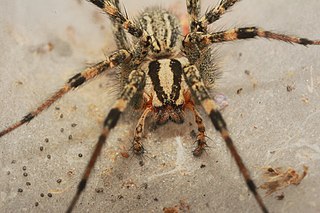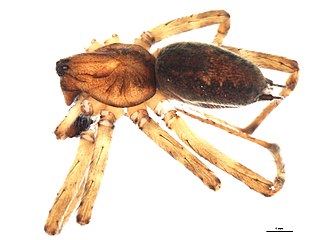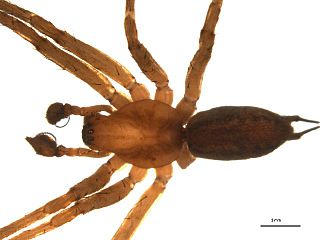
The hobo spider is a member of the family of spiders known colloquially as funnel web spiders, but not to be confused with the Australian funnel-web spider. Individuals construct a funnel-shaped structure of silk sheeting and lie in wait at the small end of the funnel for prey insects to blunder onto their webs. Hobo spiders sometimes build their webs in or around human habitations. The hobo spider lays its eggs in September and they hatch during late spring. After the male hobo spider mates it dies.

Agelenopsis, commonly known as the American grass spiders, is a genus of funnel weavers first described by C.G. Giebel in 1869. They weave sheet webs that have a funnel shelter on one edge. The web is not sticky, but these spiders make up for that shortcoming by running very rapidly. The larger specimens can grow to about 19 mm in body length. They may be recognized by the arrangement of their eight eyes into three rows. The top row has two eyes, the middle row has four eyes, and the bottom row has two eyes. They have two prominent hind spinnerets, somewhat indistinct bands on their legs, and two dark bands running down either side of the cephalothorax.

The Agelenidae are a large family of spiders in the suborder Araneomorphae. Well-known examples include the common "grass spiders" of the genus Agelenopsis. Nearly all Agelenidae are harmless to humans, but the bite of the hobo spider may be medically significant, and some evidence suggests it might cause necrotic lesions, but the matter remains subject to debate. The most widely accepted common name for members of the family is funnel weaver.

A spinneret is a silk-spinning organ of a spider or the larva of an insect. Some adult insects also have spinnerets, such as those borne on the forelegs of Embioptera. Spinnerets are usually on the underside of a spider's opisthosoma, and are typically segmented. While most spiders have six spinnerets, some have two, four, or eight. They can move both independently and in concert.

Agatoxins are a class of chemically diverse polyamine and peptide toxins which are isolated from the venom of various spiders. Their mechanism of action includes blockade of glutamate-gated ion channels, voltage-gated sodium channels, or voltage-dependent calcium channels. Agatoxin is named after the funnel web spider which produces a venom containing several agatoxins. There are different agatoxins. The ω-agatoxins are approximately 100 amino acids in length and are antagonists of voltage-sensitive calcium channels and also block the release of neurotransmitters. For instance, the ω-agatoxin 1A is a selective blocker and will block L-type calcium channels whereas the ω-agatoxin 4B will inhibit voltage sensitive P-type calcium channels. The μ-agatoxins only act on insect voltage-gated sodium channels.

Agelenopsis aperta, also known as the desert grass spider or funnel-web spider, is a species of spider belonging to the family Agelenidae and the genus Agelenopsis. It is found in dry and arid regions across the southern United States and into northwestern Mexico. Their body is about 13–18 mm long and they have relatively long legs in order to run after their prey. Desert grass spiders can withstand very low temperatures even though they do not cold harden. It constructs the characteristic funnel-shaped webs in crevices where the funnel will fit, where they wait in the tube for prey which they can run after using their long legs. They often hunt for their prey at night.
Grass spider may refer to:
Susan Elise Riechert is an American behavioral ecologist known for her research on evolutionary game theory and the behavior of spiders. She is also known for her "biology in a box" teaching materials, used by hundreds of thousands of elementary and secondary school students in Tennessee. Until her retirement in 2020, she worked at the University of Tennessee as UTK Distingushed Service Professor and as UTK Chancellors Professor of Ecology & Evolutionary Biology. She was president of the American Arachnological Society for 1983–1985, and president of the Animal Behavior Society in 1997.

Agelenopsis potteri is a species of funnel weaver in the spider family Agelenidae. Native to North America, it has been introduced into Ukraine, Russia, and Kirgizstan.
Agelenopsis kastoni is a species of funnel weaver in the spider family Agelenidae. It is found in the United States.

Agelenopsis oregonensis is a species of funnel weaver in the spider family Agelenidae. It is found in the United States and Canada.

Agelenopsis emertoni is a species of funnel weaver in the family of spiders known as Agelenidae. It is found in the United States. The spider was named to honour arachnologist James H. Emerton. A. emertoni is distinguished from other Agelenopsis species in the genus by the male's loosely coiling embolus making more than one full circle, and a claw-like conductor tip. These features are sclerites of the male sex organ which is used to inseminate the female. The female has a distinctive conducting tube in her genitalia. The male can be between 6 and 13mm. Distribution is in the following states of the USA: Arkansas, Colorado, Florida, Georgia, Louisiana, Massachusetts, Mississippi, Missouri, New Jersey, New York, North Carolina, Oklahoma, Pennsylvania, Tennessee, Texas, Virginia.
Agelenopsis pennsylvanica, commonly known as the Pennsylvania funnel-web spider or the Pennsylvania grass spider, is a species of spider in the family Agelenidae. The common name comes from the place that it was described, Pennsylvania, and the funnel shape of its web. Its closest relative is Agelenopsis potteri.

Agelenopsis utahana is a species of funnel weaver in the spider family Agelenidae. It is found in the United States and Canada.
Austrarchaea aleenae is a species of spider in the family Archaeidae. It is endemic to south-east Queensland, Australia where it may be found in the Bulburin National Park and Kalpowar State Forest.

Agelenopsis oklahoma is a species of funnel weaver in the spider family Agelenidae. It is found in the United States and Canada.
Agelenopsis longistyla is a species of funnel weaver in the spider family Agelenidae. It is found in the United States.
Agelenopsis riechertae is a species of funnel weaver in the spider family Agelenidae. It is found in the United States.
Agelenopsis spatula is a species of funnel weaver in the spider family Agelenidae. It is found in the United States.










